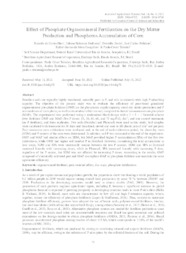Effect of phosphate organomineral fertilization on the dry matter production and phosphorus accumulation of corn.
Effect of phosphate organomineral fertilization on the dry matter production and phosphorus accumulation of corn.
Author(s): DIAS, R. de C.; STAFANATO, J. B.; ZONTA, E.; POLIDORO, J. C.; GONÇALVES, R. G. da M.; TEIXEIRA, P. C.
Summary: Brazilian soils are typically highly weathered, naturally poor in P, and rich in minerals with high P-adsorbing capacity. The objective of th e present study was to evaluate the efficiency of peat-based granulated organomineral phosphate fertilizer (OMF) on the phosphorus supply capacity, shoot dry matter production and P accumulation of corn plants, as well as its residual effect on soil, compared to that of monoammonium phosphate (MAP). The experimental was performed using a randomized block design with a 2 × 5 + 1 factorial scheme (two fertilizer: OMF and MAP; five P doses: 15, 30, 45, 60, and 75 mg P2O 5 dm-3 , and one control treatments (no P fertilizer), and three replicates. Two soils (Ferralsol and Planosol) were used in this study. Soil samples were incubated with limestone for 30 days and then dried, sieved and used to fill plastic pots (3 dm3 soil per pot). Four successive corn cultivations were evaluated and, at the end of each cultivation period, the shoot dry mass (SDM) and P content of the corn were determined. In addition, soil P was measured at the end of the experiment. OMF and MAP had similar effects on SDM, but MAP provided higher P accumulation (SPA) of the first two cultivations, while OMF had higher soil residual P in Ferralsol. However, considering the total accumulated in four crops, SDM and SPA were statistically similar between the two P sources. SDM and SPA in Ferralsol increased linearly with increasing doses, while in Planosol, SPA increased linearly with increasing P dose, regardless of the P source, but SDM was not affected by increasing P doses. According to the results, OMF composed of chemically activated peat and MAP can replace MAP as phosphate fertilizer and maintain the same agronomic efficiency.
Publication year: 2022
Types of publication: Journal article
Unit: Embrapa Soils
Observation
Some of Embrapa's publications are published as ePub files. To read them, use or download one of the following free software options to your computer or mobile device. Android: Google Play Books; IOS: iBooks; Windows and Linux: Calibre.
Access other publications
Access the Agricultural Research Database (BDPA) to consult Embrapa's full library collection and records.
Visit Embrapa Bookstore to purchase books and other publications sold by Embrapa.

